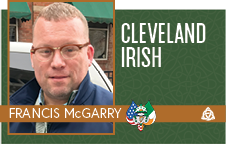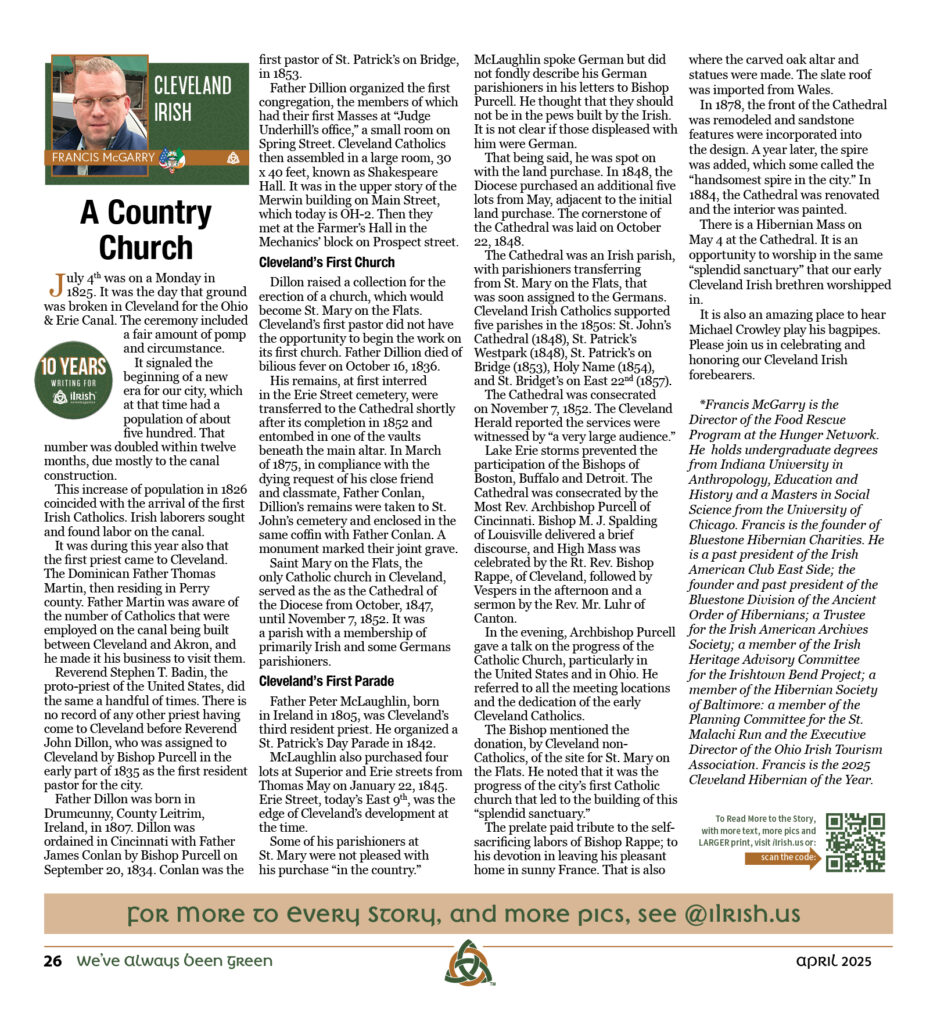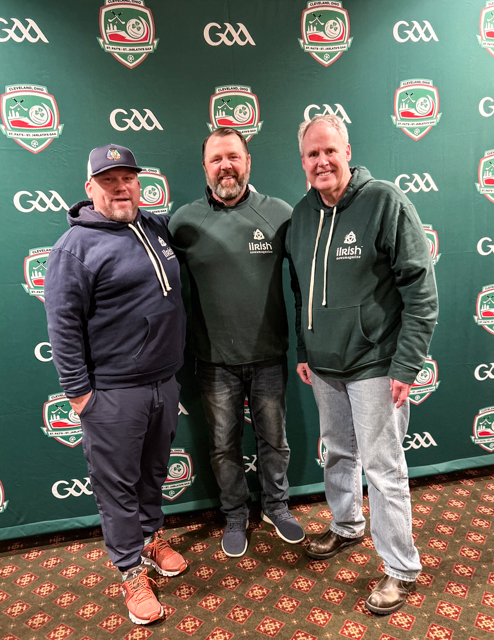
By Francis McGarry
July 4th was on a Monday in 1825. It was the day that ground was broken in Cleveland for the Ohio & Erie Canal. The ceremony included a fair amount of pomp and circumstance.
It signaled the beginning of a new era for our city, which at that time had a population of about five hundred. That number was doubled within twelve months, due mostly to the canal construction.
This increase of population in 1826 coincided with the arrival of the first Irish Catholics. Irish laborers sought and found labor on the canal.
It was during this year also that the first priest came to Cleveland. The Dominican Father Thomas Martin, then residing in Perry county. Father Martin was aware of the number of Catholics that were employed on the canal being built between Cleveland and Akron, and he made it his business to visit them.
Reverend Stephen T. Badin, the proto-priest of the United States, did the same a handful of times. There is no record of any other priest having come to Cleveland before Reverend John Dillon, who was assigned to Cleveland by Bishop Purcell in the early part of 1835 as the first resident pastor for the city.
Father Dillon was born in Drumcunny, County Leitrim, Ireland, in 1807. Dillon was ordained in Cincinnati with Father James Conlan by Bishop Purcell on September 20, 1834. Conlan was the first pastor of St. Patrick’s on Bridge, in 1853.
Father Dillion organized the first congregation, the members of which had their first Masses at “Judge Underhill’s office,” a small room on Spring Street. Cleveland Catholics then assembled in a large room, 30 x 40 feet, known as Shakespeare Hall. It was in the upper story of the Merwin building on Main Street, which today is OH-2. Then they met at the Farmer’s Hall in the Mechanics’ block on Prospect street.
Cleveland’s First Church
Dillon raised a collection for the erection of a church, which would become St. Mary on the Flats. Cleveland’s first pastor did not have the opportunity to begin the work on its first church. Father Dillion died of bilious fever on October 16, 1836.
His remains, at first interred in the Erie Street cemetery, were transferred to the Cathedral shortly after its completion in 1852 and entombed in one of the vaults beneath the main altar. In March of 1875, in compliance with the dying request of his close friend and classmate, Father Conlan, Dillion’s remains were taken to St. John’s cemetery and enclosed in the same coffin with Father Conlan. A monument marked their joint grave.
Saint Mary on the Flats, the only Catholic church in Cleveland, served as the as the Cathedral of the Diocese from October, 1847, until November 7, 1852. It was a parish with a membership of primarily Irish and some Germans parishioners.
Cleveland’s First Parade
Father Peter McLaughlin, born in Ireland in 1805, was Cleveland’s third resident priest. He organized a St. Patrick’s Day Parade in 1842.
McLaughlin also purchased four lots at Superior and Erie streets from Thomas May on January 22, 1845. Erie Street, today’s East 9th, was the edge of Cleveland’s development at the time.
Some of his parishioners at St. Mary were not pleased with his purchase “in the country.” McLaughlin spoke German but did not fondly describe his German parishioners in his letters to Bishop Purcell. He thought that they should not be in the pews built by the Irish. It is not clear if those displeased with him were German.
That being said, he was spot on with the land purchase. In 1848, the Diocese purchased an additional five lots from May, adjacent to the initial land purchase. The cornerstone of the Cathedral was laid on October 22, 1848.
The Cathedral was an Irish parish, with parishioners transferring from St. Mary on the Flats, that was soon assigned to the Germans. Cleveland Irish Catholics supported five parishes in the 1850s: St. John’s Cathedral (1848), St. Patrick’s Westpark (1848), St. Patrick’s on Bridge (1853), Holy Name (1854), and St. Bridget’s on East 22nd (1857).
The Cathedral was consecrated on November 7, 1852. The Cleveland Herald reported the services were witnessed by “a very large audience.”
Lake Erie storms prevented the participation of the Bishops of Boston, Buffalo and Detroit. The Cathedral was consecrated by the Most Rev. Archbishop Purcell of Cincinnati. Bishop M. J. Spalding of Louisville delivered a brief discourse, and High Mass was celebrated by the Rt. Rev. Bishop Rappe, of Cleveland, followed by Vespers in the afternoon and a sermon by the Rev. Mr. Luhr of Canton.
In the evening, Archbishop Purcell gave a talk on the progress of the Catholic Church, particularly in the United States and in Ohio. He referred to all the meeting locations and the dedication of the early Cleveland Catholics.
The Bishop mentioned the donation, by Cleveland non-Catholics, of the site for St. Mary on the Flats. He noted that it was the progress of the city’s first Catholic church that led to the building of this “splendid sanctuary.”
The prelate paid tribute to the self-sacrificing labors of Bishop Rappe; to his devotion in leaving his pleasant home in sunny France. That is also where the carved oak altar and statues were made. The slate roof was imported from Wales.
In 1878, the front of the Cathedral was remodeled and sandstone features were incorporated into the design. A year later, the spire was added, which some called the “handsomest spire in the city.” In 1884, the Cathedral was renovated and the interior was painted.
There is a Hibernian Mass on May 4 at the Cathedral. It is an opportunity to worship in the same “splendid sanctuary” that our early Cleveland Irish brethren worshipped in.
It is also an amazing place to hear Michael Crowley play his bagpipes. Please join us in celebrating and honoring our Cleveland Irish forebearers.




